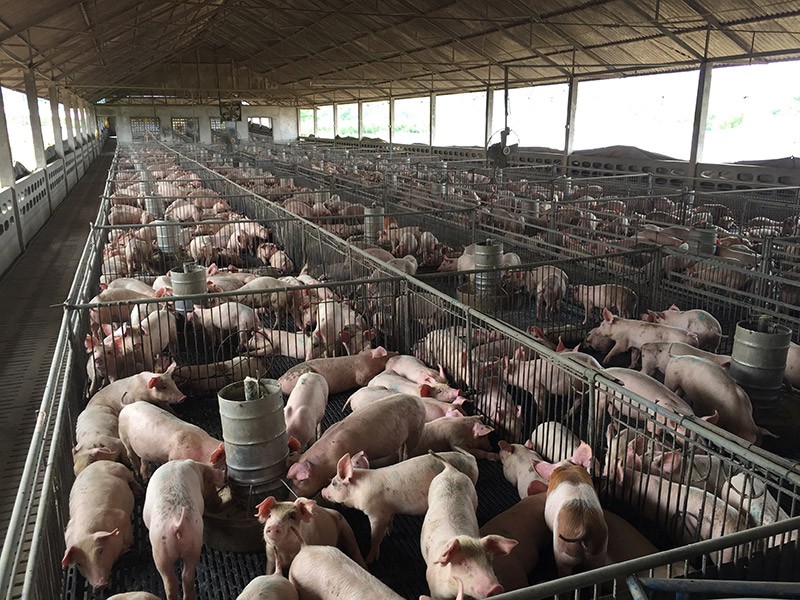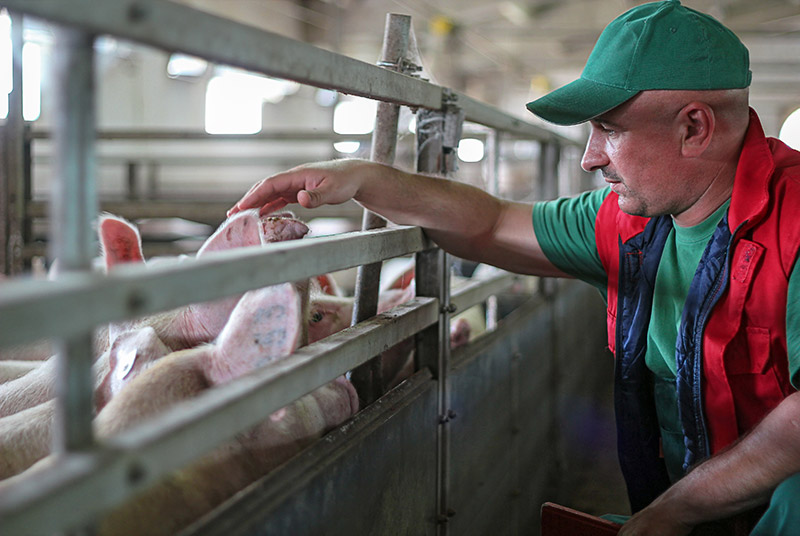Section 3 | Porcine Respiratory Disease
Industry
Page 11 /
The Usual Suspects: Pathogens of PRD
Respiratory disease in pigs is complex. There are many factors that can produce or contribute to respiratory disease in pigs, including1:
- Bacteria or viruses
- Environmental stressors
- Different production systems
- Various management practices
- If the herd has been exposed to the pathogen previously

Given the fact that there are a variety of causes and risk factors that may be present, the term porcine respiratory disease (PRD) is used to describe the condition.
Clinically, pigs with PRD are anorexic (reduced feed intake), have fevers (body temperature > 39.2°C), cough, and have rapid or difficult breathing. These symptoms result in poor production (reduced efficiency and growth rates) and death.
PRD rates vary widely from herd to herd. Typical sickness rates range between 30-70% of growing pigs, with death rates of around 4-6%1. Obviously, some farms are higher or lower than these estimates, but PRD remains a major cause of economic loss for the industry.

The Usual Suspects: Pathogens of PRD
The bacteria and viruses that are credited with causing PRD in swine are vast. The table below, adapted from a previous review1 outlines the viruses and bacteria that can cause or contribute to PRD.
Table: Common bacteria and viruses associated with PRD
| Class | Name | Abbreviation | Major importance1 | Minor importance2 |
| Viruses | Paramyxovirus | PMV | + | |
| Porcine circovirus type 2 | PCV2 | + | ||
| Porcine cytomegalovirus | PCMV | + | ||
| Porcine reproductive and respiratory syndrome virus | PRRSV | + | ||
| Porcine respiratory coronavirus | PRCV | + | ||
| Swine influenza virus | SIV | + | ||
| Torque teno sus virus | TTSuV | + | ||
| Bacteria | Actinobacillus pleuropneumoniae | APP | + | |
| Actinobacillus suis | ASUIS | + | ||
| Truperella pyogenes | TP | + | ||
| Bordatella bronchiseptica | BORD | + | ||
| Haemophilus parasuis | HPS | + | ||
| Mycoplasma hyopneumoniae | MHYO | + | ||
| Mycoplasma hyorhinis | MHYOR | + | ||
| Pasteurella multocida | PMULT | + | ||
| Salmonella | SALM | + | ||
| Streptococcus suis |
SSUIS | + |
- 1Major importance means the ability to produce respiratory disease on its own
- 2Minor importance means that, under the right circumstances (e.g. infection with another pathogen or immune-compromised pigs), the pathogen could contribute to respiratory disease

We will give you a broad-strokes overview of the major pathogens so that you can better understand their role in PRD. This section of the module is based on an excellent review article1 that covers the multifactorial nature of PRD and associated pathogens in greater detail.
Viruses of Major Importance
PRRSV
PRRSV is among the most common bug detected in PRD. It infects cells of the immune system and respiratory tract, causing immunosuppression and respiratory disease.
SIV
SIV infects cells of the respiratory tract and causes both upper respiratory disease and pneumonia. It is a very common cause of respiratory disease in pigs.
Viruses of Minor Importance
PCV2
This virus can cause upper respiratory disease, thus predisposing the pig to infection with other viruses and bacteria. This virus can also cause immunosuppression, further increasing the potential damage caused by other pathogens. On its own, it rarely causes PRD.
Bacteria Causing PRD
MHYO
MHYO destroys the natural defences of the upper respiratory tract and predisposes the pig to infection with other bacterial pathogens. It also causes immunosuppression. It is one of the most important bacteria involved in PRD.
PMULT
PMULT is the most commonly diagnosed bacteria associated with PRD, but is thought of as an opportunistic pathogen. It is a natural inhabitant of the respiratory tract of pigs, causing disease only after other viruses and bacteria damage the immune defences.
BORD
BORD is commonly seen in younger pigs and is seen at low levels as a contributor to PRD. It attacks cells of the respiratory tract and immune system, predisposing the pig to disease.
APP
These bacteria normally live in the tonsils and nasal cavity. There are a variety of different strains that differ in the toxins they produce and their ability to evade the immune system.
HPS, SSUIS, SALM, ASUIS, TP
These bacteria may directly infect the lungs or, more often, seed the lung following a blood-borne infection.
Pathogen Interactions
Rarely is it ever the case that only one pathogen is to blame for PRD. More than likely, disease occurs in a population due to the interaction of two or more pathogens, along with environmental and management practices conducive to disease. Viral-viral, bacterial-viral, and bacterial-bacterial interactions can occur between many of the aforementioned pathogens, producing disease that is more severe than any of the pathogens alone.
This highlights the importance of working with a veterinarian to achieve an accurate diagnosis of the pathogens causing PRD on your farm.

References
- Opriessnig T, Giménez-Lirola LG, Halbur PG. Polymicrobial respiratory disease in pigs. Anim. Heal. Res. Rev. 2011;12(2):133–48.